Home » 2021
Yearly Archives: 2021
Course on “The different spatio-temporal scales of the solar magnetism”
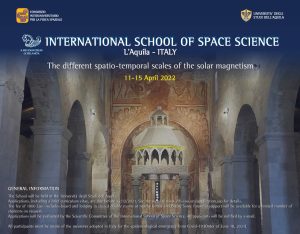
The International School of Space Science of the Consorzio Interuniversitario per la Fisica Spaziale organizes a Course on “The different spatio-temporal scales of the solar magnetism”, to be held in L’Aquila, Italy, 11-15 April, 2022 directed by Prof. F. Zuccarello (Università di Catania, Italy) and Prof. L.Bellot Rubio (Instituto de Astrofisica de Andalucía, IAA-CSIC, Spain).
The School is aimed at providing an in-depth overview of the magnetic phenomena occurring in our star, as well as at presenting some of the most recent tools that can allow to directly tackle the analysis of the problems that are still present in the comprehension of solar magnetic phenomena, through hands-on sessions.
The main topics that will be examined are: the global magnetic field of the Sun and the solar cycle; the small-scale magnetic field: emergence and evolution; the global and local dynamo; the sunspots: processes of formation and evolution and the fine-structure of umbrae and penumbrae; magnetic field instabilities, eruptive events and their impact on Space Weather.
Applications are due before November 21, 2021.
For more information visit https://www.cifs-isss.org/ or send an e-mail to ssc@aquila.infn.it
Magnetic Energy Balance in the Quiet Sun on Supergranular Spatial and Temporal Scales
Papers from SWICo members
F. Giannattasio, G. Consolini, F. Berrilli, and D. Del Moro
Small-scale magnetic fields are ubiquitous in the quiet solar photosphere and may store and transfer huge amounts of energy to the upper atmospheric layers giving rise to a chain of phenomena that are relevant for Space Weather. For this reason, it is fundamental to constrain the energetics of the quiet Sun.
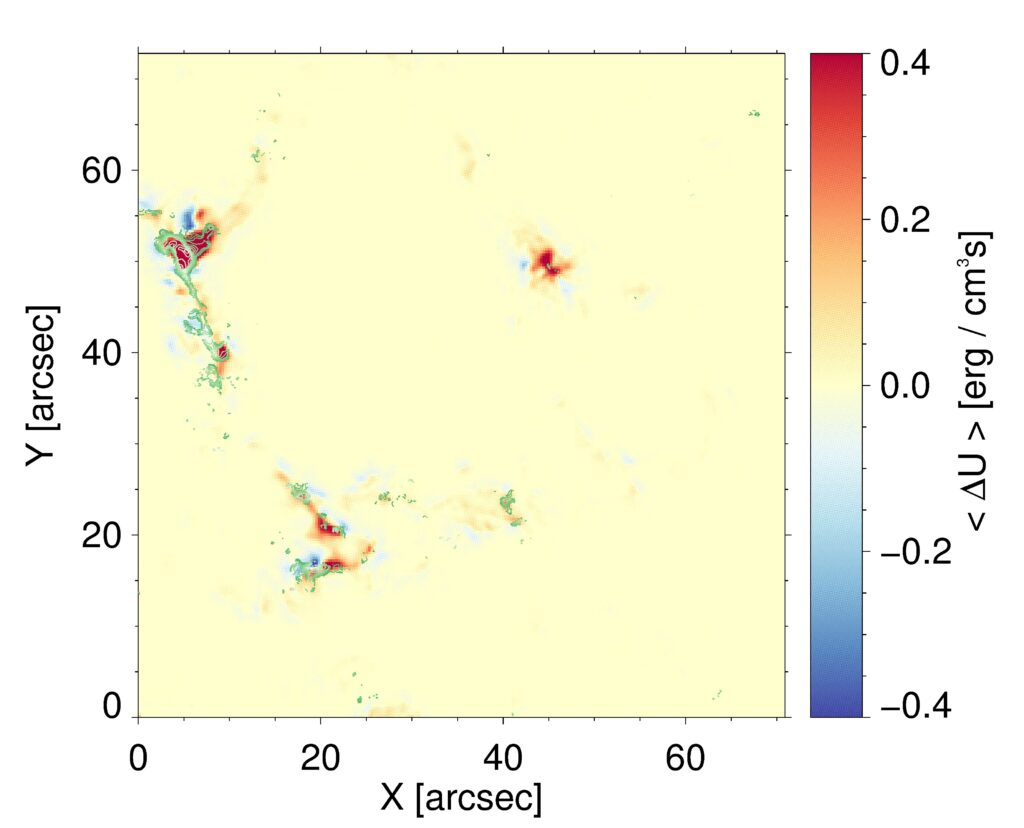
By taking advantage of a 24 hr long with 90 s cadence magnetogram time series acquired by the Hinode mission without interruption, we computed, for the first time, the average photospheric electric field, the average current density, and starting from these, the rate of change of magnetic energy density on supergranular spatial and temporal scales. The main result is that, on average, the energy provided by photospheric electric and magnetic fields and current density can sustain the magnetic fields in the network.
Publication: F. Giannattasio, G. Consolini, F. Berrilli, and D. Del Moro, Magnetic Energy Balance in the Quiet Sun on Supergranular Spatial and Temporal Scales, The Astrophysical Journal, 904, 1, 2020.
https://doi.org/10.3847/1538-4357/abbb36
Multiscale Analysis of the Turbulent Ionospheric Medium
Papers from SWICo members
P. De Michelis and R. Tozzi
The physical parameters which describe many fluid and plasma systems, such as density, velocity, temperature, and electric and magnetic fields, are often characterized by fluctuating values. When the fluctuations are observed over many spatial and temporal scales and a nonlinear transfer of energy occurs between the different scales, the system is generally said to be in a turbulent state. Several interplanetary space environments, such as solar wind, ion foreshock, the magnetosheath, and the magnetotail and, last but not least, the ionosphere, have been found to be in a turbulent state.
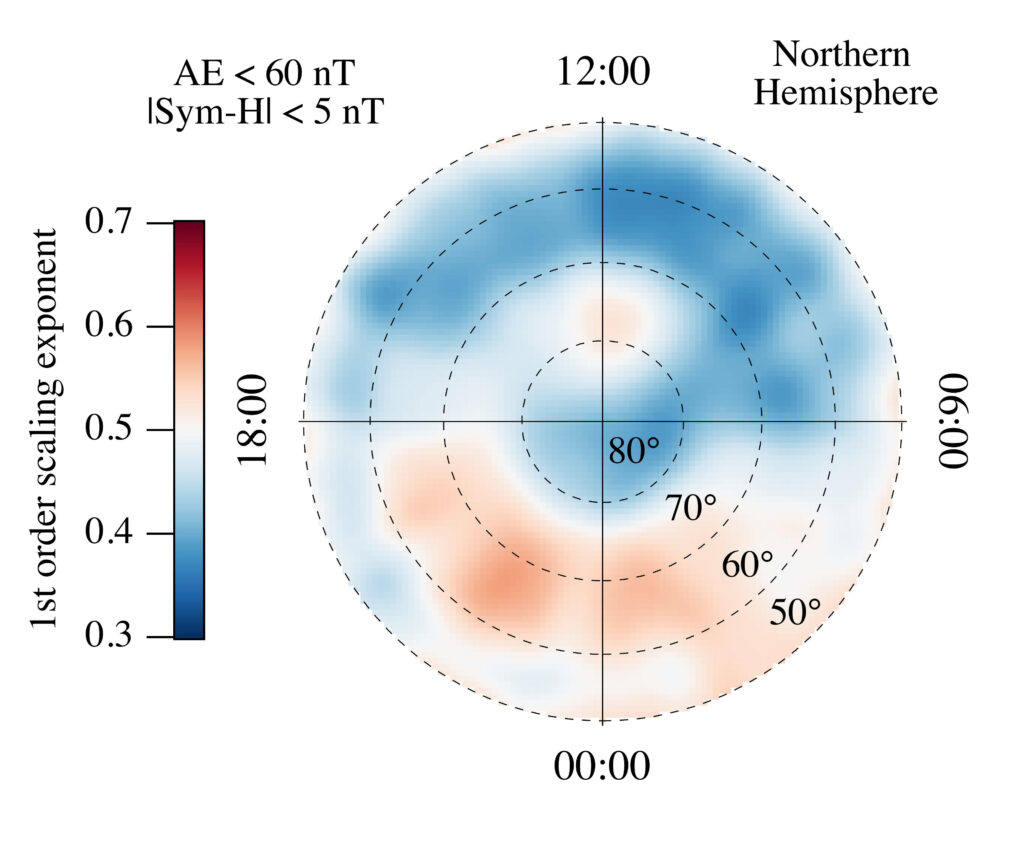
Turbulence crucially influences the cross-scale coupling of the dynamical processes: it can influence the transport of mass, momentum, and energy from solar wind and the magnetosphere to the ionosphere and can also perturb the equilibrium structure of the ionosphere, as well as the plasma dynamics and particle energization at many locations in the ionosphere. Here, we review some recent findings on the multiscale and turbulent character of the ionosphere, with a special emphasis on high-latitudes. In particular, we analyse some scaling features of magnetic field fluctuations, relating them to their spectral properties and the occurrence of intermittency phenomena.
Publication: P. De Michelis and R. Tozzi, “Multiscale Analysis of the Turbulent Ionospheric Medium”, Chapter 19 in “The Dynamical Ionosphere”, Editors: M. Materassi, B. Forte, A. Coster and S. Skone, Elsevier 2020.
https://doi.org/10.1016/B978-0-12-814782-5.00019-4
Detection Capability of Flux Ropes during the Solar Orbiter Mission
Papers from SWICo members
Telloni, Daniele; D’Amicis, Raffaella; Bruno, Roberto; Carbone, Francesco; Perrone, Denise; Zank, Gary P.; Zhao, Lingling; Nakanotani, Masaru; Adhikari, Laxman
Flux ropes are interplanetary magnetic helical structures that are receiving increasing attention because of their likely role in magnetohydrodynamic (MHD) processes as well as their impact on space weather science. A very promising and powerful approach to address their investigation and characterization is based on wavelet spectrograms of the invariants of the ideal MHD equations.
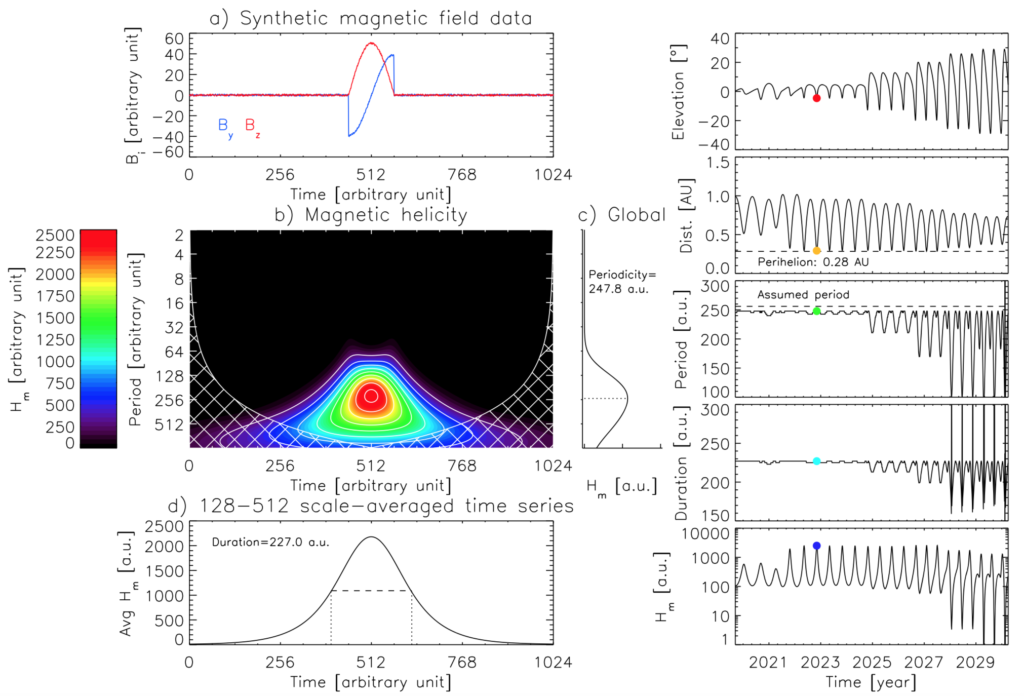
The accuracy of this method to infer flux rope properties depends on the proper evaluation of the direction of propagation of the flux rope itself, which is often difficult to assess. We present a numerical test of the reliability of this diagnostic technique, by simulating a synthetic flux rope of fixed size and propagation direction along the Solar Orbiter orbit, that is very elongated and inclined with respect to the orbital plane. We find that when the flux rope is crossed for less than 50% of its width, the procedure becomes unreliable. Quantitative information on how to properly recover the flux-rope intrinsic properties is provided.
Publication: Telloni D., D’Amicis R., Bruno R., Carbone F., Perrone D., Zank G. P., Zhao L., et al., 2020, ApJL, 899, L25.
https://iopscience.iop.org/article/10.3847/2041-8213/abacc4
Study of the Influence of the Solar Wind Energy on the Geomagnetic Activity for Space Weather Science
Papers from SWICo members
Telloni, Daniele; Carbone, Francesco; Antonucci, Ester; Bruno, Roberto; Grimani, Catia; Villante, Umberto; Giordano, Silvio; Mancuso, Salvatore; Zangrilli, Luca
This paper addresses the investigation of the interaction of the solar wind energy with the Earth’s magnetosphere, by studying its correlation with the disturbance storm time (Dst) index, a proxy of the geomagnetic activity. Some relevant parameters of the solar wind (the bulk speed and the z-component of the interplanetary magnetic field) are explored in the energy-Dst space.
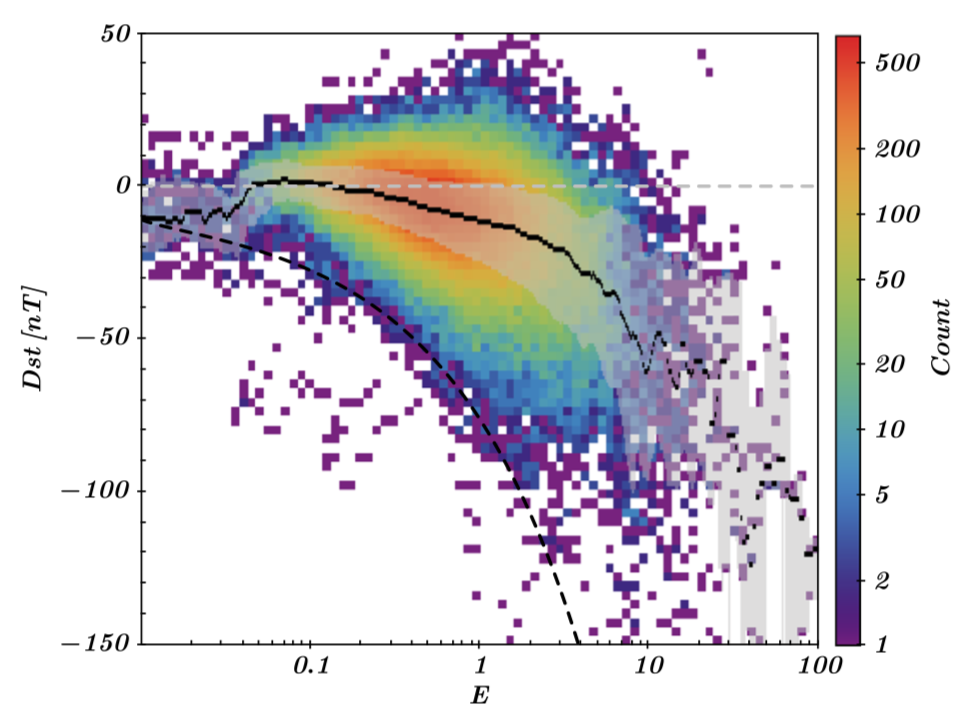
It results that (I) the solar wind energy and the geomagnetic activity are strictly related, with the coronal mass ejections representing the most energetic and geoeffective driver; (II) the slow solar wind has negligible effects on Earth regardless of its energy content, whereas high-speed streams may induce severe geomagnetic storming depending on the advected energy; and (III) while at low and mid energies, geomagnetic disturbances are induced provided the magnetic reconnection between the interplanetary and terrestrial magnetic fields occurs, high-energy solar wind plasma can impact Earth even without reconnecting with the geomagnetic field at the dayside magnetopause. The most significant result in the framework of space weather science resides in the observational evidence that the Earth’s magnetosphere has a maximum response to the energetic content of the solar wind, which leads to the derivation of an empirical law allowing the proper forecast of the upper limit of the intensity of any geomagnetic disturbance on the basis of the solar wind energy derived in situ at the Lagrangian point L1.
Publication: Telloni D., Carbone F., Antonucci E., Bruno R., Grimani C., Villante U., Giordano S., et al., 2020, ApJ, 896, 149.
https://iopscience.iop.org/article/10.3847/1538-4357/ab91b9/pdf
Detection of Coronal Mass Ejections at L1 and Forecast of Their Geoeffectiveness
Papers from SWICo members
Daniele Telloni , Ester Antonucci, Alessandro Bemporad, Tiziano Bianchi, Roberto Bruno, Silvano Fineschi, Enrico Magli, Gianalfredo Nicolini, and Roberto Susino
A novel tool aimed to detect solar coronal mass ejections (CMEs) at the Lagrangian point L1 and to forecast their geoeffectiveness is presented in this paper. This approach is based on the analysis of in situ magnetic field and plasma measurements to compute some important magnetohydrodynamic quantities of the solar wind (the total pressure, the magnetic helicity, and the magnetic and kinetic energy), which are used to identify the CME events, that is their arrival and transit times, and to assess their likelihood for impacting the Earths magnetosphere.
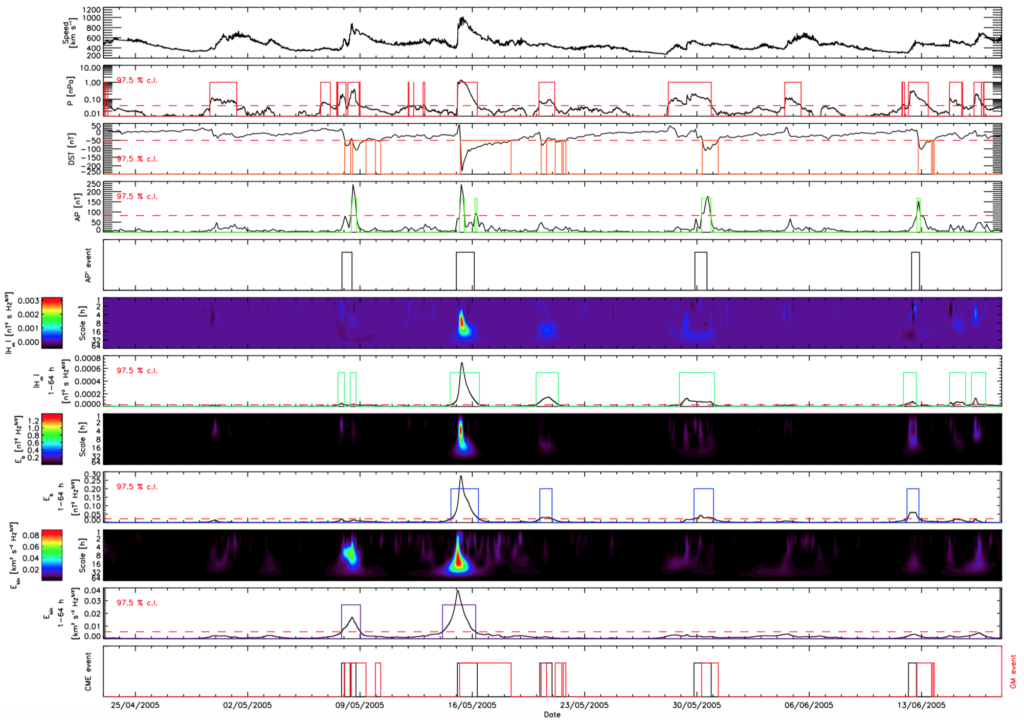
The method is essentially based on the comparison of the topological properties of the CME magnetic field configuration and of the CME energetic budget with those of the quasi-steady ambient solar wind. The algorithm performances are estimated by testing the tool on solar wind data collected in situ by the Wind spacecraft from 2005 to 2016. In the scanned 12 yr time interval, it results that (i) the procedure efficiency is of 86% for the weakest magnetospheric disturbances, increasing with the level of the geomagnetic storming, up to 100% for the most intense geomagnetic events, (ii) zero false positive predictions are produced by the algorithm, and (iii) the mean delay between the potentially geoeffective CME detection and the geomagnetic storm onset if of 4 hr, with a 98% 2-8 hr confidence interval. Hence, this new technique appears to be very promising in forecasting space weather phenomena associated to CMEs.
Publication: Telloni D., Antonucci E., Bemporad A., Bianchi T., Bruno R., Fineschi S., Magli E., et al., 2019, ApJ, 885, 120. doi:10.3847/1538-4357/ab48e9
https://iopscience.iop.org/article/10.3847/1538-4357/ab48e9/pdf
Lower-thermosphere response to solar activity: an empirical-mode-decomposition analysis of GOCE 2009-2012 data
Papers from SWICo members
Alberto Bigazzi, Carlo Cauli, and Francesco Berrilli
The thermosphere is a layer of the high Earth atmosphere which extends into the Low Earth orbit (LEO) region. It is extremely sensitive to the activity of our star, especially to solar radiation in X-rays and ultraviolet. When the sun is at a minimum of activity, as in these years, its X-rays and UV emission is reduced and the thermosphere cools and collapses. On the contrary, when solar activity increases the thermosphere expands and penetrates into circumterrestrial space.
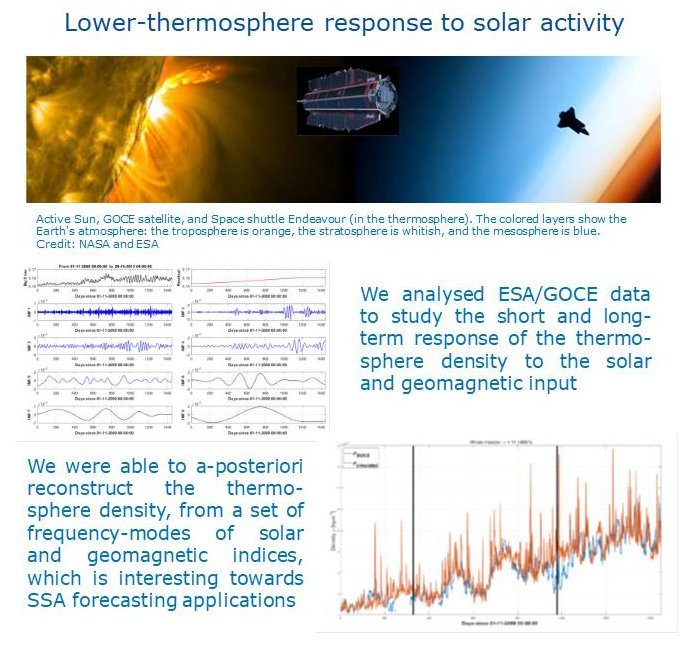
Since about 70% of the current operative satellites are in LEO, the expansion of the thermosphere increases drag on satellites and, changing their orbits, increases the need for orbital maneuvers with effects on orbital station-keeping and satellite life-time. The same effect is present in the case of the space debris (over 70% of the debris are in LEO).
By analyzing more than four years of data from extremely precise accelerometers, capable of measuring small accelerations (1 part out of 10 million of Earth’s gravity acceleration), on board the ESA/GOCE mission we connected the density variations of the thermosphere to the solar and geomagnetic activity. In order to model the density of the thermosphere to the solar and magnetospheric signals, we used the frequency modes that have the greatest impact on the thermosphere’s density.
Publication: Bigazzi A, Cauli C., Berrilli F., 2020, Annales Geophysicae, Volume 38, Issue 3, 2020, pp.789-800, DOI: 10.5194/angeo-38-789-2020 https://angeo.copernicus.org/articles/38/789/2020/angeo-38-789-2020.pdf
Intermittency and Passive Scalar Nature of Electron Density Fluctuations in the High-Latitude Ionosphere at Swarm Altitude
Papers from SWICo members
G. Consolini, P. De Michelis, T. Alberti, I. Coco, F. Giannattasio, R. Tozzi, and V. Carbone
The Sun interaction with the magnetosphere-ionosphere system can induce turbulent fluctuations in magnetic and electric fields and plasma density in the high-latitude ionosphere, particularly during geomagnetically disturbed periods. Here, we focus on the electron density fluctuations as observed by one of the satellites of the ESA Swarm constellation, and we show how such fluctuations are strongly intermittent in nature. Furthermore, we demonstrate that the anomalous scaling features of the electron density fluctuations are those expected for a passive scalar quantity in fluid turbulence.
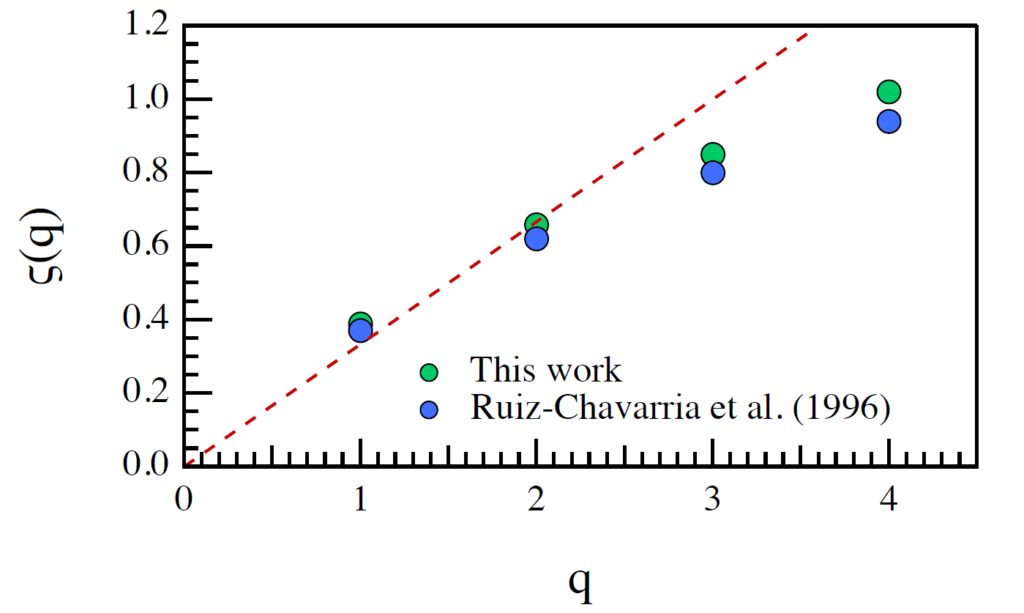
Publication: G. Consolini, P. De Michelis, T. Alberti, I. Coco, F. Giannattasio, R. Tozzi, and V. Carbone, Intermittency and Passive Scalar Nature of Electron Density Fluctuations in the High-Latitude Ionosphere at Swarm Altitude, Geophys. Res. Lett., 2020.
https://doi.org/10.1029/2020GL089628
On the 2015 St. Patrick Storm Turbulent State of the Ionosphere: Hints from the Swarm Mission
Papers from SWICo members
P. De Michelis, A. Pignalberi, G. Consolini, I. Coco, R. Tozzi, M. Pezzopane, F. Giannattasio and G. Balasis
We analysed the electron density fluctuations in the high-latitude ionosphere during the St. Patrick’s geomagnetic storm occurred on 17 March 2015, in order to investigate the possible turbulent nature of the ionospheric plasma. Electron density measurements were taken in both hemispheres from two of the three ESA Swarm satellites (A and B), covering the time period between 16 and 22 March 2015.
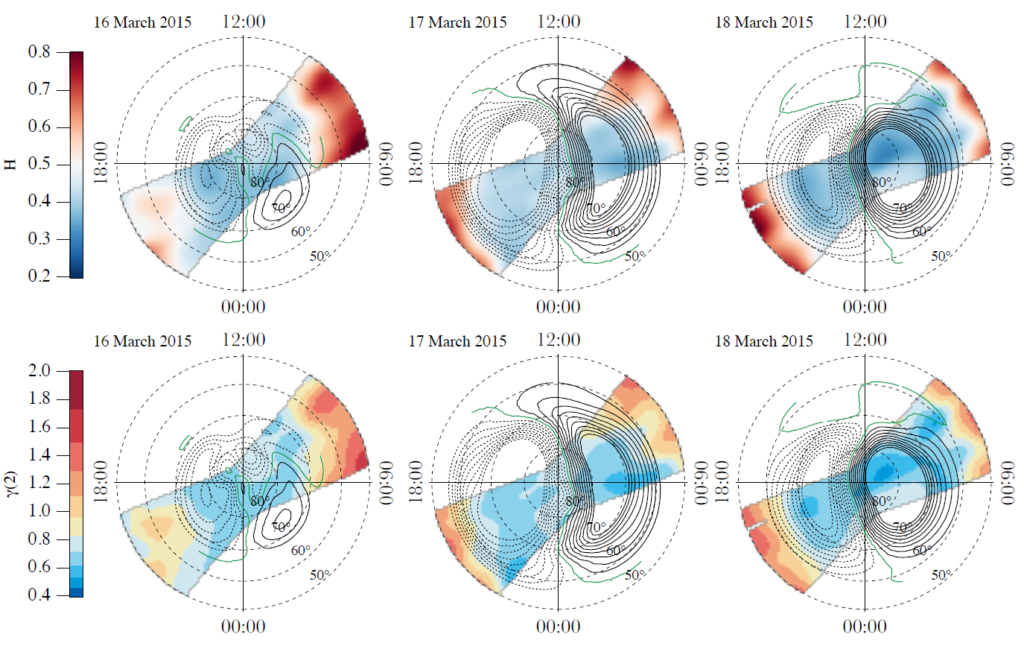
We reconstructed the Rate Of change of electron Density Index (RODI), which can be considered as a proxy for the presence of plasma irregularities, and compared it with quantities related to the spectral properties of the electron density fluctuations. We found that, independently of the different phases of the analyzed geomagnetic storm, the observed fluctuations pattern seems to support the idea of a fluid and/or magnetohydrodynamic turbulence as the main cause of the high values of RODI recorded at high latitudes in the auroral and polar cap regions.
Publication: P. De Michelis, A. Pignalberi, G. Consolini, I. Coco, R. Tozzi, M. Pezzopane, F. Giannattasio and G. Balasis, On the 2015 St. Patrick Storm Turbulent State of the Ionosphere: Hints from the Swarm Mission, J. Geophys. Res.: Space Physics, 125, 2020.
https://doi.org/10.1029/2020JA027934
Linear vs nonlinear methods for detecting magnetospheric and ionospheric current systems patterns
Papers from SWICo members
T. Alberti, F. Giannattasio, P. De Michelis and G. Consolini.
The geomagnetic field time series can be viewed as a superposition of signals which represent the different contributions to it at different scales coming from various sources both internal and external to the Earth. Here, we apply two different methods of analysis in order to recognize in the magnetic field of external origin the different contributions coming from external sources, making use of measurements of the vertical component of the geomagnetic field (directed away from the Earth’s center) recorded by the European Space Agency (ESA) Swarm A and B satellites at low and mid latitudes during a geomagnetically quiet period.
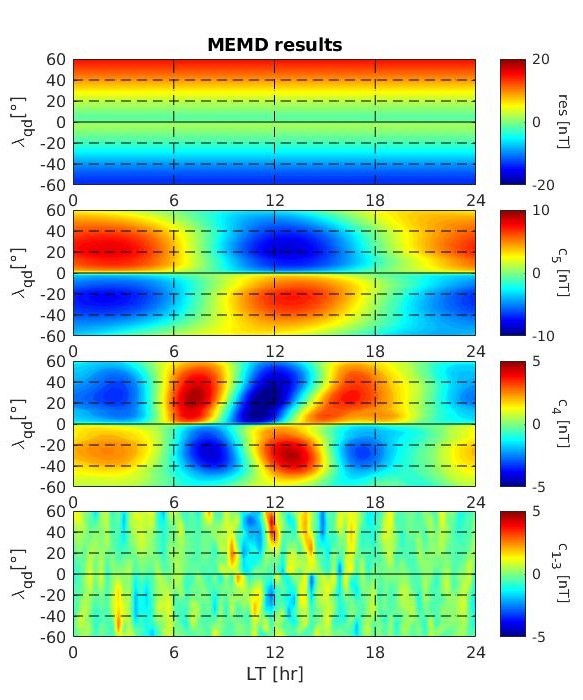
The first is a linear method, that is, the Empirical Orthogonal Functions (EOF); the second is a nonlinear one, i.e. the Multivariate Empirical Mode Decomposition (MEMD). As the external contributions to the magnetic signal are intrinsically nonlinear, the MEMD seems to give better results with respect to EOF, and only five modes and a residue are necessary to reproduce the different contributions coming from the external sources against the 26 modes that are necessary in the case of the EOF. This study is an example of the potential of the MEMD for the analysis of the geomagnetic field of external origin, and of its capability to separate the ionospheric from the magnetospheric contributions in a simple and rapid way.
Publication: T. Alberti, F. Giannattasio, P. De Michelis and G. Consolini, Linear vs nonlinear methods for detecting magnetospheric and ionospheric current systems patterns, Earth and Space Science, 2020.
https://doi.org/10.1029/2019EA000559
